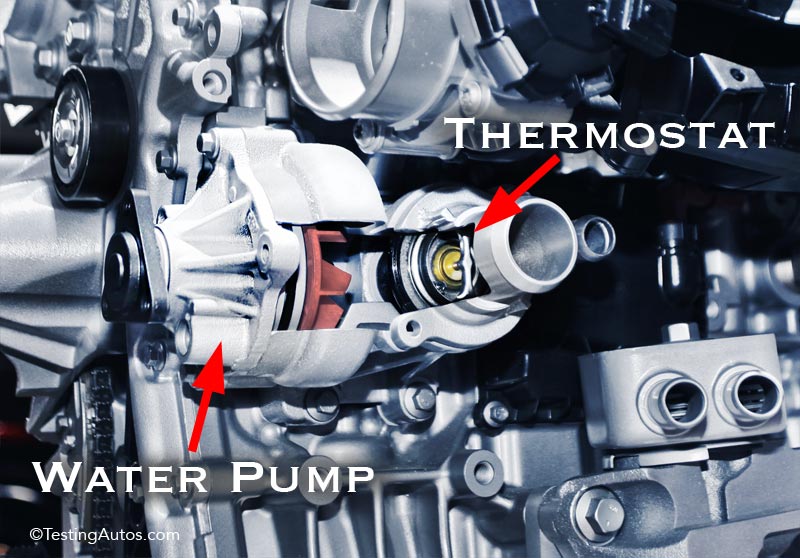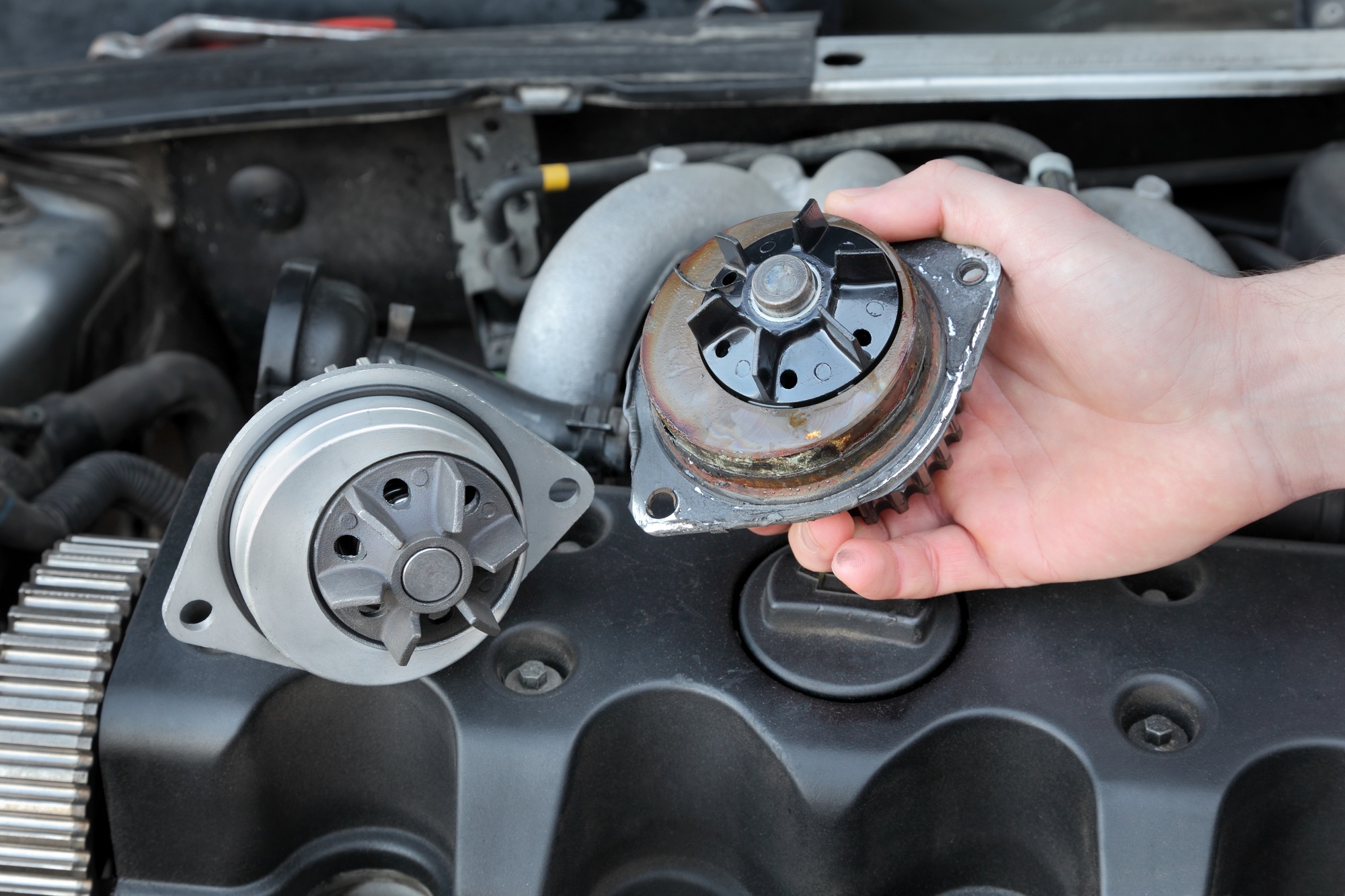Yes, you should replace the thermostat when replacing the water pump. This ensures both parts function well together and prevents potential issues.
When working on your vehicle’s cooling system, both the water pump and thermostat play crucial roles. The water pump moves coolant through the engine, while the thermostat regulates temperature. If one fails, the other can be affected. Replacing both parts at the same time can save you from future headaches and costly repairs.
It also ensures your engine runs smoothly. We will explore why this is important and how it benefits your car’s performance. Stay with us to learn more about maintaining your vehicle’s cooling system effectively.
Role Of The Thermostat
The thermostat plays a crucial role in the engine’s cooling system. It helps maintain the optimal temperature for engine efficiency. Understanding its role can help decide if you should replace the thermostat when replacing the water pump.
Function In Engine Cooling System
The thermostat regulates the engine’s temperature. It does this by controlling the flow of coolant. When the engine is cold, the thermostat stays closed. This allows the engine to warm up quickly. Once the engine reaches the ideal temperature, the thermostat opens. This lets the coolant flow, preventing the engine from overheating.
The thermostat’s role is vital for keeping the engine at a consistent temperature. It ensures the engine runs efficiently. Without a functioning thermostat, the engine could overheat or run too cold. Both scenarios can lead to engine damage or reduced performance.
Common Issues And Failures
Like any part, thermostats can fail. Common issues include the thermostat sticking open or closed. A stuck-open thermostat can prevent the engine from reaching its optimal temperature. This can lead to poor fuel efficiency and increased emissions.
A stuck-closed thermostat can cause the engine to overheat. Overheating can lead to severe engine damage. Replacing a faulty thermostat is cheaper than fixing an overheated engine.
Other issues include leaks or corrosion. These can affect the thermostat’s performance. Regular checks can help identify these issues early. Addressing them promptly can save time and money.

Credit: www.testingautos.com
Role Of The Water Pump
The water pump is a key component in your car’s engine. It ensures the engine stays cool by circulating coolant. Without it, your engine could overheat and suffer severe damage.
Function In Engine Cooling System
The water pump pushes coolant through the engine block. It absorbs heat from the engine and moves to the radiator. In the radiator, the heat is released into the air. This process repeats to keep the engine at a safe temperature.
| Component | Role |
|---|---|
| Water Pump | Circulates coolant |
| Radiator | Dissipates heat |
| Thermostat | Regulates coolant flow |
Common Issues And Failures
Water pumps can fail for various reasons. A common issue is a leaking water pump. This can lead to coolant loss and overheating. Another issue is a broken impeller. This stops the pump from moving coolant effectively.
- Leaking seals
- Corroded parts
- Broken impeller
When the water pump fails, it can also affect the thermostat. If the pump doesn’t work, the coolant doesn’t flow. This can cause the thermostat to misread temperatures. It might stay closed, causing the engine to overheat.
Replacing the thermostat when you change the water pump is wise. It ensures both parts are in good condition. This can prevent future cooling system failures.
Signs Of A Failing Thermostat
Recognizing the signs of a failing thermostat is crucial. It helps you avoid engine damage. A thermostat regulates your engine’s temperature. When it fails, it can cause various issues. Below are some common signs of a failing thermostat.
Overheating Engine
An overheating engine is a clear sign. A faulty thermostat can restrict coolant flow. This causes the engine to overheat. Overheating can lead to serious damage. Always monitor your engine’s temperature gauge.
Erratic Temperature Readings
Erratic temperature readings are another sign. Your temperature gauge may fluctuate. This indicates the thermostat is not working correctly. It might open and close inconsistently. Pay attention to these fluctuations. They can signal a failing thermostat.

Credit: stevesimports.com
Signs Of A Failing Water Pump
Recognizing the signs of a failing water pump can save you from bigger issues. The water pump plays a crucial role in your vehicle’s cooling system. If it fails, your engine can overheat, leading to severe damage. Here are some common signs of a failing water pump:
Coolant Leaks
One clear sign is coolant leaks. You might notice puddles of coolant under your car. This usually happens when the water pump’s seals wear out. Inspect your car regularly for such leaks. Quick action can prevent major problems.
Grinding Noises
Another sign is grinding noises coming from the engine. These noises often indicate a worn-out water pump bearing. If you hear grinding, check the water pump immediately. Ignoring it can lead to complete failure and costly repairs.
Benefits Of Replacing Both
Replacing your thermostat when replacing the water pump can offer several benefits. It ensures your car runs smoothly and prevents future issues. Here are some key reasons to consider replacing both components.
Preventative Maintenance
Replacing the thermostat along with the water pump can prevent future breakdowns. A new thermostat ensures proper temperature regulation. This reduces the risk of overheating. Preventative maintenance saves you from unexpected car troubles.
Cost And Time Efficiency
Replacing both parts at once can be more cost-effective. You save on labor costs by combining the repairs. It also saves time. Your car spends less time in the shop. This means you get back on the road faster.
Potential Risks Of Not Replacing Both
Replacing a water pump is vital for your engine’s health. But should you also replace the thermostat? Ignoring this question can lead to several risks. Here are the potential dangers of not replacing both parts at the same time.
Increased Repair Costs
When you replace the water pump, the engine’s cooling system is already open. This is the perfect time to replace the thermostat. If you don’t, you might face higher repair costs later. The thermostat could fail soon after the pump replacement. This means another trip to the mechanic. You will pay for labor and parts all over again.
By replacing both parts together, you save on labor costs. Mechanics don’t have to open the cooling system twice. This saves you money in the long run. It also saves you time and hassle.
Risk Of Engine Damage
The thermostat regulates the engine’s temperature. A failing thermostat can cause the engine to overheat. Overheating can lead to severe engine damage. This damage might require extensive repairs. In some cases, you might need a new engine. This is costly and inconvenient.
Replacing both parts ensures the cooling system works efficiently. A new thermostat will work well with the new water pump. This reduces the risk of overheating. It keeps your engine in good shape for longer.
Professional Advice
Replacing a water pump can be a tricky task. You might wonder if you should replace the thermostat too. Professional advice can help you decide. Experts recommend considering several factors. These factors include your car’s age and condition.
Mechanic Recommendations
Most mechanics suggest replacing the thermostat with the water pump. Why? Both parts work closely together. A new water pump can cause an old thermostat to fail. This can lead to overheating issues. Changing both parts at once saves time and money. It also ensures your car runs smoothly.
Case Studies And Examples
Consider John’s experience. He replaced his water pump but not the thermostat. A week later, his car overheated. He had to replace the thermostat. This cost him more money and time.
On the other hand, Lisa replaced both parts together. Her car ran perfectly after the repair. No overheating issues occurred. Mechanics use these examples to show the benefits of replacing both parts at once.

Credit: www.youtube.com
Frequently Asked Questions
Should You Replace The Thermostat With A New Water Pump?
Yes, it’s smart to replace the thermostat. They work together to keep the engine cool.
What Happens If You Don’t Replace The Thermostat?
Not replacing it can lead to overheating. This may cause engine damage.
How Often Should You Replace The Thermostat?
Every time you replace the water pump. It’s a good maintenance practice.
Can A Bad Thermostat Damage The New Water Pump?
Yes, a bad thermostat can cause the pump to fail. It’s best to replace both.
Is It Expensive To Replace Both The Water Pump And Thermostat?
Costs vary by car model. It’s cheaper than fixing engine damage later.
Conclusion
Replacing both the thermostat and water pump can prevent future issues. This ensures smoother engine performance. It saves time and potential labor costs. Small investments now can prevent costly repairs later. Expert advice can guide your decision. Keep your vehicle running efficiently.
Regular maintenance keeps your car reliable. Your engine will thank you. Choose wisely for long-term benefits. Happy driving!
